Posts Tagged: Lynn Kimsey
Invasive paper wasp responsible for increasing yellow jacket complaints
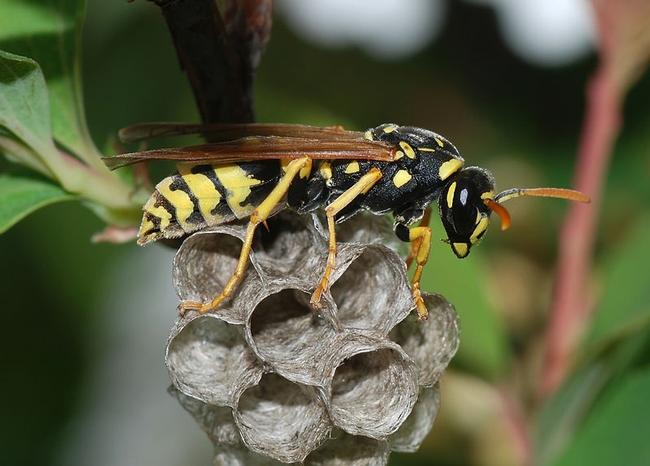
"The European paper wasp, which is about the same size (as the yellow jacket) but more slender, has built up to enormous numbers in some communities," said Lynn Kimsey, professor in the Department of Entomology at UC Davis. "They have been making their way out of the Sacramento area for the past 20 years."
Kimsey said the wasps have moved outward from Sacramento along river beds and water ways into the Sierra Nevada and along the delta toward San Francisco. In August, 345 wasp nests were removed in South Lake Tahoe.
European paper wasps dine on caterpillars, aphids and honeybees, but switch to mostly carbohydrates in the late summer for energy, said Andrew Sutherland, UC Cooperative Extension advisor in the Bay Area.
Vernard Lewis, UCCE specialist in the Department of Environmental Science, Policy and Management at UC Berkeley, also contributed to the story.
"Where I normally eat my lunch is one of the biggest yellow jacket nests I've seen in years," Lewis said. "It's not just here. I'm getting reports from the Berkeley campus and from Richmond, Antioch and Rodeo. Something is up. It's not just yellow jackets. It's other pests, too, like cockroaches. It's the most I've seen in at least 10 or 15 years."
Fimrite added a link in his article to the UC Statewide IPM Program Pest Note on Yellowjackets and other social wasps.
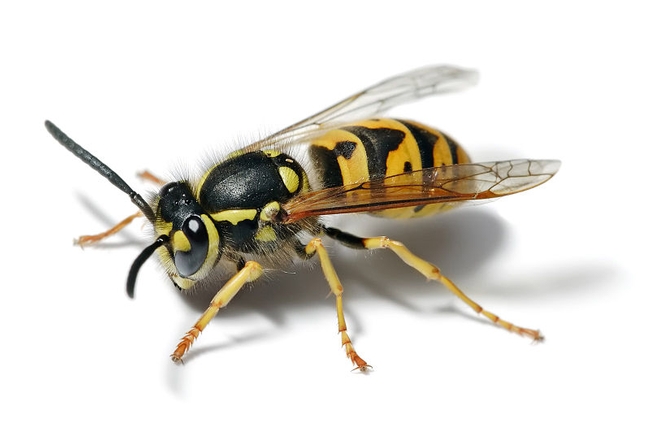
Yellow jackets, like the one above, are often confused with European paper wasps. (Photo: Wikimedia Commons)
These bees 'cut it'
We're in the midst of a housing crisis, so why not build a 30-unit, high-rise condo in your yard?
No, not for people--for native bees.
We just installed a bee condo for leafcutting bees (Megachile spp.), on a five-foot high pole overlooking catmint, lavender and salvia. The "housing development" is actually a wooden board drilled with small holes to accommodate our tiny tenants. Comfy and convenient. Rooms with a view. No housing permits or EIR required. Rent-free, mortgage-free.
Leafcutting bees, aka leafcutter bees, are about the size of a honey bee but darker, with the characteristic light-banded abdomens. They are important pollinators.
Why are they called leafcutter bees? Because the females cut leaf fragments to construct their nests to raise their brood. In nature, they build their nests in soft, rotted wood or in the pithy stems of such plants as roses, raspberries, sumac and elderberry.
Unlike honey bees, which are social, the leafcutting bee is a solitary nesting bee. She provisions her leaf-lined nest with nectar and pollen, lays an egg, and seals the cell before leaving.
Commercially made bee condos are available at beekeeping supply stores or on the Internet. You can make or buy a board with different sized-holes so other native bees, such as blue orchard bees, aka mason bees, receive a "home, sweet home," too, and deliver pollinator services.
And enable you to tell your family and friends that you're a "bee landlord" or beekeeper.
The Xerces Society for Invertebrate Conservation offers tips on building bee condos on its website and in its publications, including Farming for Bees: Guidelines for Providing Native Bee Habitat on Farms.
If you don't want bee boards housing your tenants, you can provide straws or hollow bamboo stems.
At the UC Davis Department of Entomology, doctoral candidate Emily Bzdyk is doing research on leafcutter bees. "Basically I'm doing a revision of the subgenus Litomegachile, part of the large genus Megachile, which includes leafcutter and resin bees," she said. "They are native to North America. My goals are to find out how many and what the species are in Litomegachile, and find out as much as I can about their biology, or how they make a living."
"I also want to identify clearly what the boundaries between the species are, or how to tell them apart from one another," said Bzdyk, whose major professor is Lynn Kimsey, director of the Bohart Museum of Entomology. "Litomegachile are very common and hard-to-identify to species, and I feel they deserve attention."
Bzdyk noted that some Megachile are used in commercial alfalfa production. The alfalfa leafcutter bee, native to Europe, is used for commercial pollination of alfalfa, she said. "The Litomegachile is probably very closely related."
The alfalfa growers erect giant bee condos in their fields to draw bees to their plants.
With home gardeners, the effect is the same.
If you build them, they will come.
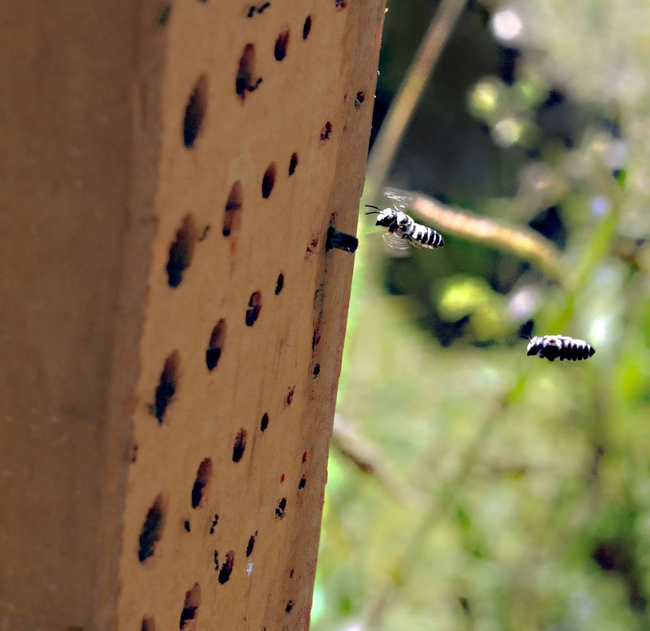
Leafcutting bees, aka leafcutter bees (genus Megachile) head toward a bee condo built for these and other pollinators. (Photo by Kathy Keatley Garvey)
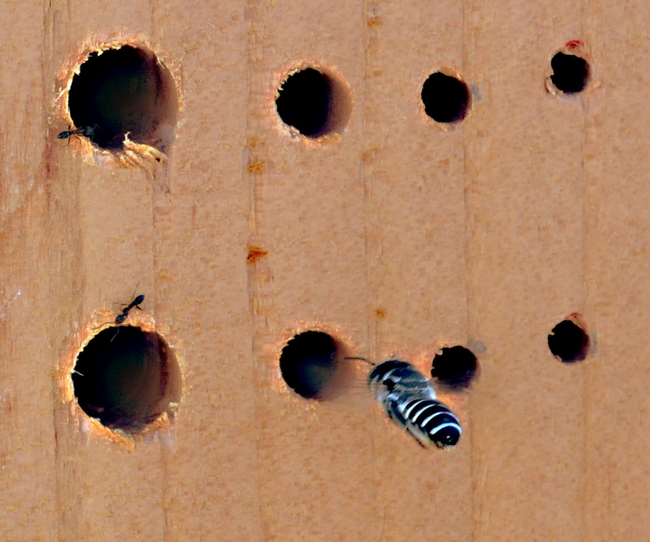
Home sweet home: Oblivious to ants, a leafcutter bee heads for home. (Photo by Kathy Keatley Garvey)
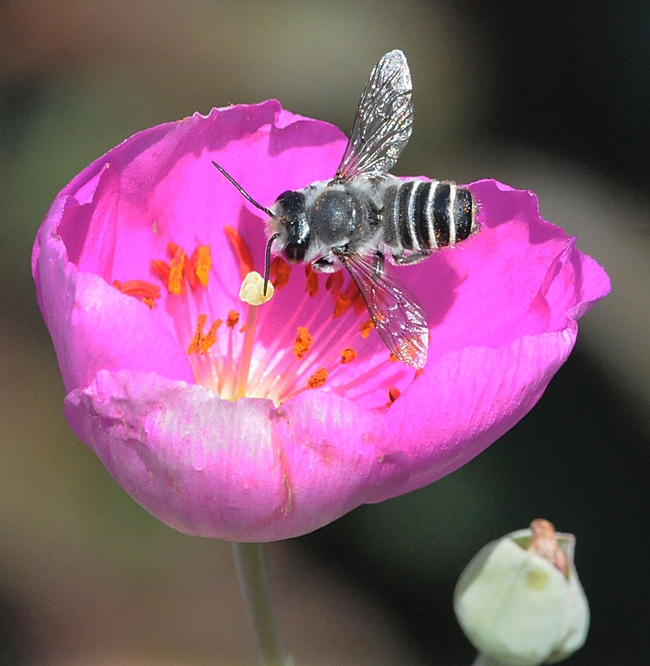
Male leafcutter bee (genus Megachile) sips nectar from a rock purslane. (Photo by Kathy Keatley Garvey)
Thousand cankers disease in Central Valley
UC Cooperative Extension orchard systems farm advisor Elizabeth Fichtner believes farmers should monitor their walnut orchards for signs of thousand cankers disease. Infected trees, she says, should be cut down and burned.Thousand cankers disease has been threatening black walnut trees in 15 California counties for several years; six infected trees were found in Tulare County since last year, according to an article in the Visalia Times-Delta. Fichtner said she began finding the disease in Fresno County a couple of weeks ago.
The fungus has also been found in Arizona, New Mexico, Colorado, Idaho, Oregon, Utah and Washington state. It was detected in Tennessee in July.
"We really don't know where it came from," the article quoted UC Davis entomologist Lynn Kimsey.
Fichtner said the disease is spread by the walnut twig beetle, which burrows below the bark to make spaces to breed. The fungus spores are carried on their bodies when they enter the tree.
The first symptoms are the cankers, each with a tiny beetle burrow hole at the center. Later leaves yellow and branches die. Because there are no known treatments for the fungus, eventually it kills infected trees.
On the bright side, one infected tree doesn't mean the whole orchard will succumb. Fichtner told the reporter that the walnut twig beetle produces an aggregation pheromone, so all of the beetles tend to attack one tree.
Nevertheless, research entomologist Steve Seybold of the USDA Forest Service Pacific Southwest Research Station said the disease is pervasive in many California cities and towns.
"I really don't see much hope for combating this disease," Seybold was quoted.
More information about thousand cankers disease is on the UC Davis Department of Entomology website.
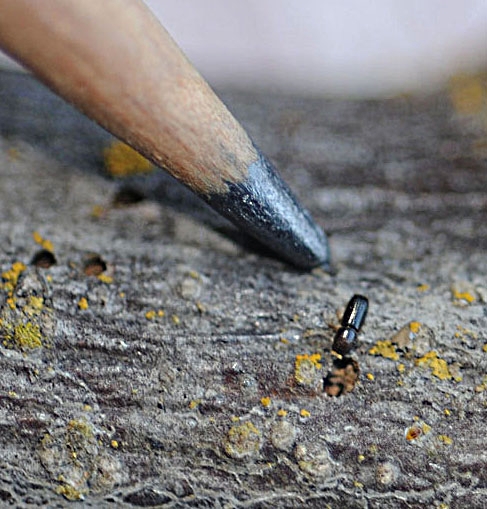
Walnut twig beetles carry the deadly fungus into trees. (Photo by Kathy Garvey)